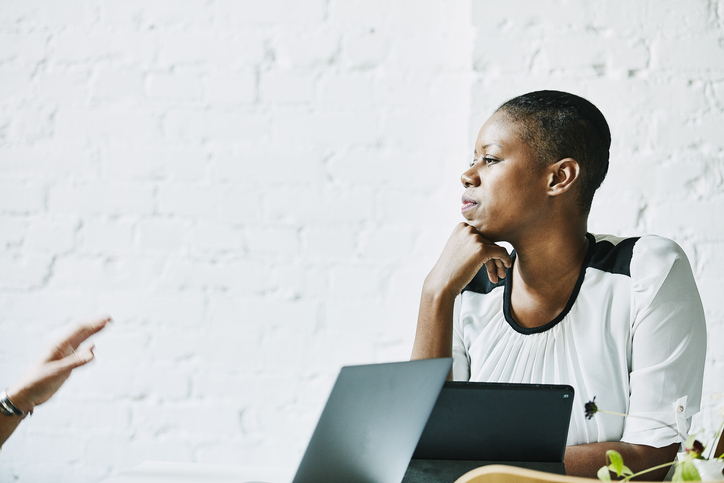
Source: Thomas Barwick / Getty
It’s been nearly four years since the ‘me too’ movement launched conversations about sexual violence and the dynamics of rape culture into the forefront of our collective public consciousness. As we close out Sexual Assault Awareness Month this April, we must reckon with whether we’ve made real progress since 2017 to disrupt rape culture and ask critical questions about what survivors need to feel safe. Safe spaces should center the lives and experiences of those of us who are most marginalized among survivors, including Black trans and cis women, those who are gender-nonconforming, and intersex people. Truly safe spaces must ensure our safety from all forms of harm including that of which is state-sanctioned, and sexual violence.
I was painfully reminded of those intersections last week when Ma’Khia Bryant was killed by police in my hometown of Columbus, Ohio, just minutes before the Derek Chauvin trial verdict was announced. Her death reminded me that Black women, girls, and trans people aren’t valued by our society. From having our humanity ripped from us through rape and sexual violence, to being murdered by the state even when we’re the ones who call for help, anti-Black racism and rape culture combine to tell us we lack value. It’s an all-too-common reality that our survivor-led movement must face and challenge.
Considering all of the harm that Black survivors have experienced — the past administration, the nearly decade-long racial reckoning, and the grief unleashed on us due to COVID-19 — it’s inspiring to know that we have remained uncompromisingly committed to ending sexual violence and rape culture. The work is hard, particularly for the survivors whose brilliance fuels much of it. Still, thanks to more public discourse about survival, trauma, and resilience, we’ve seen a widespread call for safe spaces. In their truest sense, they’re the places and settings where we can show up as our most vulnerable, imperfect selves; where our feelings are held with a level of care and consideration; and where harm is reduced because shared values and commitments have been established.
For those of us working in service to survivors and other impacted communities — many of us living as impacted people ourselves — evaluating whether our safe spaces are actually safe, and if so for whom, has been a hard but necessary practice.
Essentially, safe spaces include our family and friend circles, faith and spiritual communities, affinity groups, and social clubs based on shared identities, interests, and/or zip codes. Yet, it’s unsettling that rates of both state-sanctioned and sexual violence persist in these spaces. With that in mind — even if it’s not occurring in front of our faces — the way that we discuss these forms of violence matters.
The persistent reality of state-sanctioned violence creates a perpetual fear in our homes, streets, and neighborhoods — all of which are meant to be our spaces that are safe. Not only do they become unsafe when harmful acts take place inside them, but the safety of the spaces, respectfully, are increasingly determined by how we respond in moments of crisis. For instance, right now, we are searching to make sense of how the state enacts violence against Black bodies. That is its own kind of spiritual trauma, especially for those of us who identify as survivors. Adding to that vulnerability in our most intimate safe spaces, national statistics confirm that acts of sexual violence are overwhelmingly committed by people who know their victim/victims and who navigate the same communities as them. This level of familiarity, coupled with normalized behaviors like weaponizing loyalty to silence survivors (i.e. the correlation between Black women’s loyalty to Black men and the limited number of Black survivors reporting sexual violence) is precisely why we can’t assume rape culture isn’t present in the spaces that seem safest to us.
Understanding rape culture and how to support survivors of sexual violence – whether the perpetrators are intimate partners or people working for the state – isn’t something that happens automatically. Consciousness and commitment to a set of values has to come from a series of pivotal moments strung together by periods of education, reflection, hard work, and mistakes. Those moments, like the one we experienced in 2017, trigger radical shifts in how we see ourselves, our neighbors, and the rules that govern our society.
Back in 2017, survivors forced us to think critically about how rape culture manifests and thrives, why sexual violence isn’t addressed as the public health crisis that it is, and why stories of sexual violence center perpetrators and shift blame onto the harmed. That moment of collective conscious-shifting — driven by movement organizing — created opportunities for change. Even so, it’s during the lulls when perhaps we’re not being activated by a crisis dominating mainstream media and pop culture that we must strive to deepen our assessment of what elements of rape culture exist in the intimate spaces that we occupy.
It, rape culture, persists where agency and accountability don’t. If we’re honest with ourselves, so many of our “safe spaces” are ridden with unchecked power and selective respectability politics. On a personal level, one of the hardest places for me to assess was my sister-friend circle. There’s so much we have in common in terms of shared experiences and I know they’d do anything for me. However, I know we don’t all share the same analysis of rape culture. For me, the adage that people have a right to their opinion has some validity, but not where rape culture or other socialized ideas about who holds the responsibility of preventing rape, harassment, and/or other forms of violence are concerned. My ears perked up during a conversation that developed into the assertion that women shouldn’t wear revealing clothing around other women’s male partners because it’s “tempting.” I said to myself at that moment amongst my friends, “Dang, here too?” As a survivor, it made me uncomfortable, but I appreciated the opportunity it gave me to engage those women — whom I love — in a different kind of conversation about power, blame, and shame.
What we need are new ways of being in relationships with each other where we practice love with accountability and consistently ask ourselves and each other difficult questions. We need to move closer to what actually constitutes a safe space for all survivors, especially Black trans and cis women.
For many of us, it’s easier to hold anonymous systems accountable rather than to hold up a mirror to those close to us. And that’s not a judgment, as there are generations of experience illuminating why family and intercommunity conversations about sexual violence and rape culture are hard and sometimes dangerous for the most vulnerable in our communities.
Hopefully, we can commit to asking ourselves the following questions about the places where we find refuge, our “safe spaces,” so that we can make personal adjustments to minimize the perpetuation of rape culture.
- What about this space makes me feel safe?
- Do I feel safe here physically, emotionally, and spiritually? And if the answer to any of those is no, what makes me feel unsafe or uncomfortable?
- Have I seen rape culture manifest in this space? If so how?
- Have I participated in conversations that perpetuated a particular idea about sexual violence or a survivor?
- Was I silent during a conversation that perpetuated a particular idea about sexual violence or rape culture? If so, what prevented me from speaking up?
- What can we do together in the space to grow in our understanding of rape culture?
We can’t undo the harm caused by rape culture, but we can work together to interrupt it. Everyone knows a survivor, and honestly, there are probably several navigating your safe spaces, too. Let’s commit to taking the steps we need to in order to create authentic safe spaces and ensure that the next generation can experience safety in all its forms.
Chelsea Fuller (she/her), Deputy Director of Communications at Blackbird and Senior Communications Advisor, me too. International


